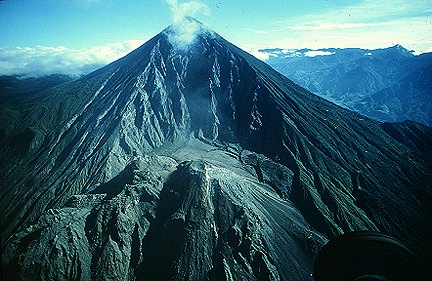 Santa Maria, the 1902 crater, and Santiaguito (foreground). Photographs are copyrighted and provided by Steve and Donna O'Meara of Volcano Watch International. Click HERE for more examples of their excellent photography.
Symmetrical, forest-covered Santa María volcano is one of the most prominent of a chain of large stratovolcanoes that rises dramatically above the Pacific coastal plain of Guatemala. The 3772-m-high stratovolcano has a sharp-topped, conical profile that is cut on the SW flank by a large, 1.5-km-wide crater. The oval-shaped crater extends from just below the summit of Volcán Santa María to the lower flank and was formed during a catastrophic eruption in 1902. The renowned plinian eruption of 1902 that devastated much of SW Guatemala followed a long repose period after construction of the large basaltic-andesite stratovolcano. The massive dacitic Santiaguito lava-dome complex has been growing at the base of the 1902 crater since 1922. Compound dome growth at Santiaguito has occurred episodically from four westward-younging vents, the most recent of which is Caliente. Dome growth has been accompanied by almost continuous minor explosions, with periodic lava extrusion, larger explosions, pyroclastic flows, and lahars.
Michigan Tech University's Volcanoes page contains detailed information about Santa Maria. Because of the high risk to people living near Santa Maria the International Association of Volcanology and Chemistry of the Earth's Interior (IAVCEI)designated it a Decade Volcano. On November 7-13, 1993 an international workshop on Santa Maria was held in Guatemala. The final report of the workshop is available byclicking here.
The southeast face of Santiaquito dome and the 1902 explosion caldera of Santa Maria. The headwaters of the Rio Nima II drainage are in the foreground at the southeast base of Santiaquito. A block lava flow, active in the late 1980's, crops out along the headwaters of the Rio Nima II.
The active El Caliente vent of Santiaquito is in the center of the photo. Santa Maria's explosion crater is in the background. The view is from the south looking north.
Santiaquito dome complex as viewed from above and just north of the dome, so that the north face is observed. To the east, El Caliente is passively degassing.
Sources of Information: Photographs by Steve and Donna O'Meara of Volcano Watch International. Global Volcanism Network, 1992, Summary of Recent Activity: Bulletin of Volcanology, v. 55, p. 141. McClelland, L., Simkin, T., Summers, M., Nielsen, E., and Stein, T.C., 1989, Global Volcanism 1975-1985: Englewood Cliffs, New Jersey, Prentice Hall, 655 p. Mercado, R., Rose, W.I., Matias, O., and Giron, J., 1988, November 1929 dome collapse and pyroclastic flow at Santiaguito dome, Guatemala: Eos, Transactions of the American Geophysical Union, v. 69, p. 1487. Mooser, F., Meyer-Abich, H., and McBirney, A.R., 1958, Central America: Catalog of Active Volcanoes of the World: Rome, IAVCEI, 6, p. 1-146. Rose, W.I., 1987, Santa Maria, Guatemala: bimodal soda-rich calc-alkaline stratovolcano: Journal of Volcanology and Geothermal Research, v. 33, p. 109-129. Rose, W.I., 1987, Volcanic activity at Santiaguito volcano, 1976-1984: Geological Society of America Special Paper, 212, p. 17-27. Rose, W.I., 1973, Pattern and mechanism of volcanic activity at Santiaguito volcanic dome, Guatemala: Bulletin of Volcanology, v. 37, p. 73-94. Rose, W.I., 1972, Notes on the 1902 eruption of Santa Maria volcano, Guatemala: Bulletin of Volcanology, v. 36, p. 29-45. Simkin, T., and Siebert, L., 1994, Volcanoes of the World: Geoscience Press, Tucson, Arizona, 349 p. Williams, S.N., and Self, S., 1983, The October 1902 Plinian eruptions of Santa Maria volcano, Guatemala: Journal of Volcanology and Geothermal Research, v. 16, p. 33-56. |